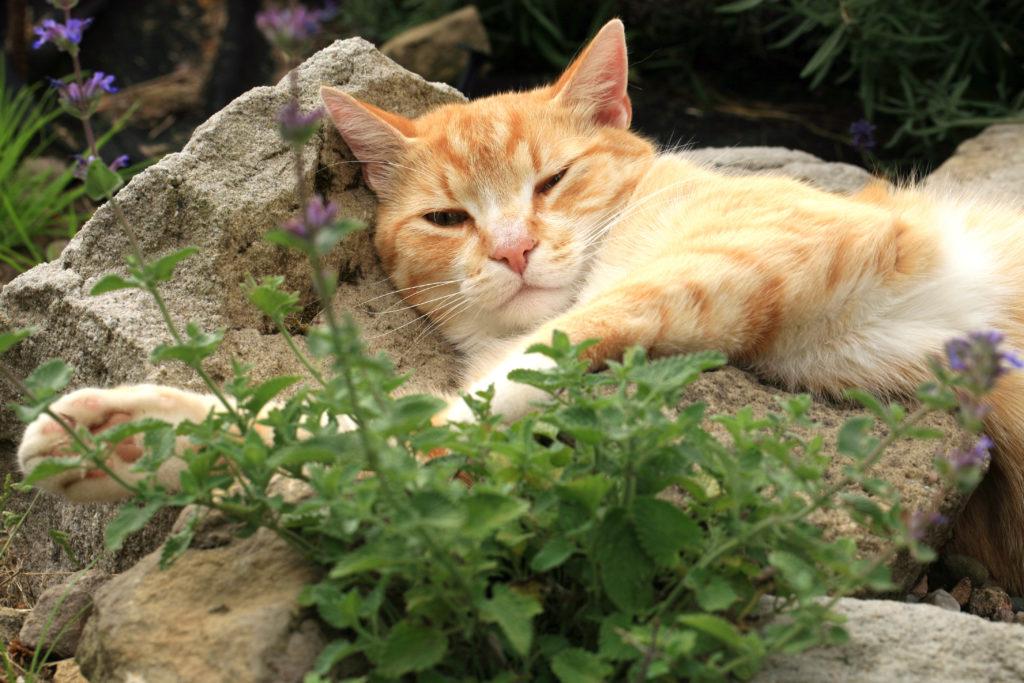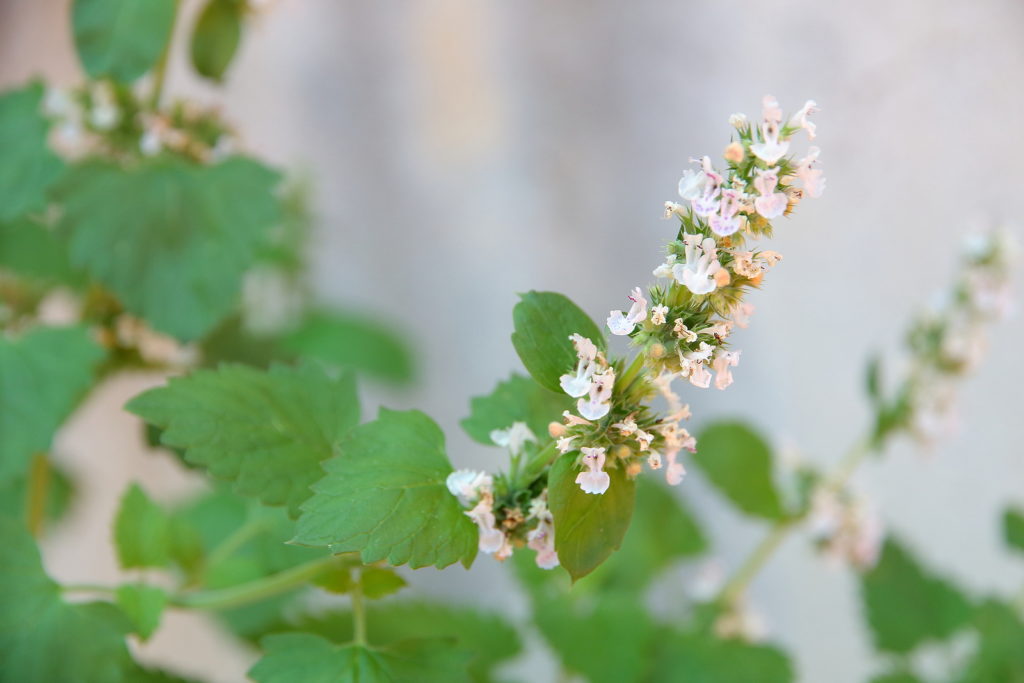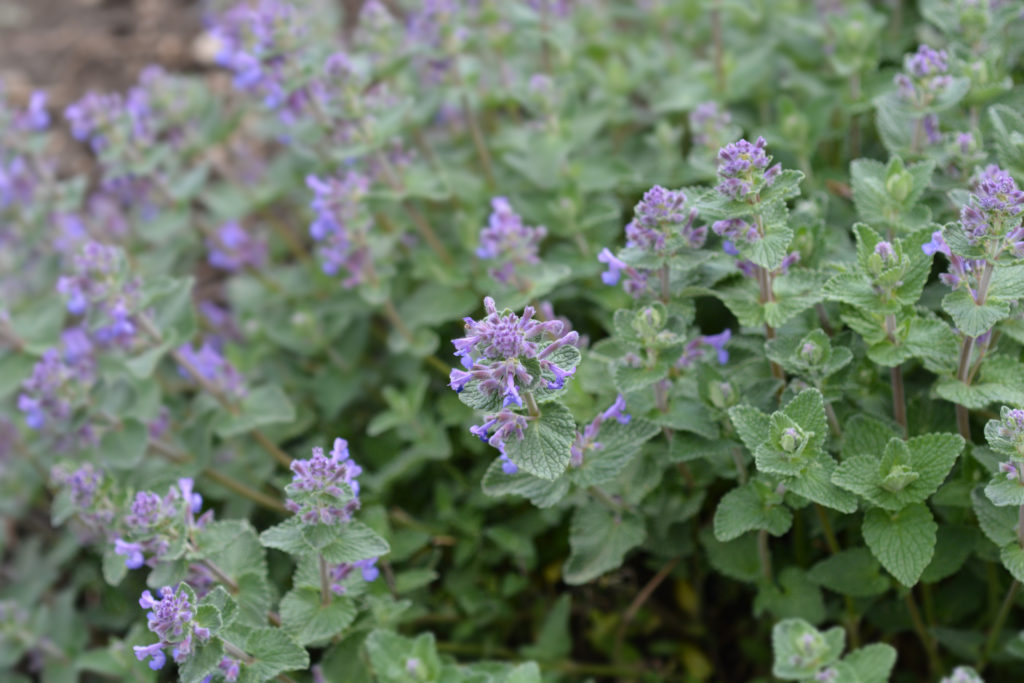Catnip is an herb that has been attracting cats for more than 2,500 years—and that’s just recorded history. The gray-green foliage when bruised or rubbed releases oil that is irresistible to cats. But catnip is not just for cats; catnip is a member of the mint family and like other mints catmint can be used in the kitchen to flavor salads and teas and on the grill to flavor meats.
Here is your complete guide to growing catnip.
Where to plant catnip
- Best location: In northern regions, plant catnip in full sun. In southern regions, plant catnip in partial shade. Start seeds in flats placed in full sun or under fluorescent lights.
- Soil preparation: Grow catnip in compost-rich, well-drained soil. Add aged compost to the planting bed and turn it under before sowing the seed. Catnip will grow in average soil. Catnip prefers a soil pH of 6.6.

When to plant catnip
- Seed starting indoors: Sow catnip seed indoors a few weeks before the last spring frost. Germination takes 7 to 10 days. Catnip seeds are very small and so are difficult to handle.
- Transplanting to the garden: Transplant catnip seedlings to the garden in mid-to late spring. If you bruise the leaves during transplanting, the oil that attracts cats will be released and it will be difficult to keep cats off the plants.
- Outdoor planting time: Sow catnip seeds in the garden after the last frost in spring and through the summer until about 6 weeks before the first fall frost.
How to plant catnip
- Planting depth: Sow seed ¼ inch deep.
- Spacing: Space catnip plants 10 to 18 inches apart. Thin plants when they are 6 to 8 inches tall.
- How much to plant: Grow 12 catnip plants for cooking, tea, and preserving.
Catnip companion plants
- Companion planting: Plant catnip near sorrel, nasturtium, sage, eggplants, and turnips. The aroma of catnip deters flea beetles, ants, spittlebugs, Japanese beetles, and weevils. However, catnip’s underground roots spread rapidly and can crowd out neighboring plants.

Watering and feeding catnip
- Watering: Water catnip just as the soil dries out. Catnip can tolerate dry soil.
- Feeding: Scratch ½ inch of compost into the top few inches of soil before planting catnip and side-dress plants with aged compost every spring. You can also feed catnip compost tea during the growing season.
Catnip care and maintenance
- Care: Cut catnip back to 3 to 4 inches above the ground after flowering; it will grow back within a couple of weeks and begin a new flowering cycle. Plants can become scraggly if not trimmed back.
- Pruning: Cut catnip back to the ground in spring to improve its growth and appearance.
- Cats ignore catnip unless the leaves are crushed. Once the leaves are bruised or crushed and the essential oils are exposed to the air, cats will roll on catnip plants. Keep catnip safe from cats by enclosing plants in a sturdy chicken-wire cage until well established.
- Catnip spreads by underground roots; keep roots and plants by surrounding the roots with metal edging.
Container growing catnip
- Container growing: Catnip is easy to grow in a container. Choose a container that is at least 6 inches wide and deep. If the container is easily accessible, expect your cat to lie in it often.
- Winter growing: Catnip can be grown indoors in winter. Protect plants outdoors under a layer of mulch. Remove the mulch after the last freeze in spring.
How to harvest catnip
- When to harvest: Snip catnip leaves anytime once the plant is 6 inches tall or taller. The flavor of catnip is milder before the plant blooms. If harvesting leaves for your cat, wait until the plant blooms.
- How to harvest: Snip off individual leaves as needed; the top leaves will be young and tender. Use scissors or snips. When harvesting to dry leaves, cut whole stems complete with their flower stalks about 2 inches from the soil surface.
Catnip pests and diseases
- Pests: Catnip rarely suffers from insect pests, but cats may nibble its leaves and can crush young plants. A spray of catnip and water will deter Colorado potato beetles.
- Diseases: Catnip can be attacked by fungal diseases including anthracnose and rust. Avoid overhead watering; space plants so that there is plenty of air circulation. Catnip can suffer root rot in wet soil; let the soil dry out between waterings.
Catnip in the kitchen
- Flavor and aroma: Catnip smells of camphor, thyme, and pennyroyal. The leaves taste mildly minty.
- Leaves: Add fresh catnip leaves to salads. Mince leaves to add a mint undertone to sauces and hearty stews. Lemon catnip can be used as a substitute for basil in pesto. Rub meat with catnip leaves before roasting or grilling.
- Teas: Make a tea from fresh or dried catnip leaves. Catnip has a flavor that is more mellow than peppermint and less sweet than spearmint. Its fragrance is spicy mint. The catnip cultivar ‘Citriodora’ is lemon-scented for flavorful teas. Tea made from catnip leaves is said to relieve indigestion, colds, and fevers.
- For cats: Chop the leaves or rub them with your fingers to release essential oils and the scent cats love.
Preserving and storing catnip
- Drying: Hang leafy stems upside down to air dry. Leaves should dry in 2 to 5 days. Strip leaves and flowers from stems and spread them to dry on a screen in the shade. The leaves also can be dried in a dehydrator.
- Storing: Store dried catnip leaves in an airtight container.

Catnip propagation
- Seed: Catnip will self-sow in the garden. Seeds will germinate best if they are stratified (exposed to freezing temperatures) for a couple of weeks before sowing.
- Cuttings: Start catnip cuttings in spring. Use 6-inch tip cuttings; dip cut stem ends in rooting hormone and plant in moist potting soil.
- Layering: New plants can be started by layering branches in the garden. Roots will grow from buried stem nodes.
- Division: Divide roots every three years in mid-spring or fall.
Catnip varieties to grow
- Another species of Nepeta is mussinii or catmint which grows in soft mounds 1 to 2 feet high with ½ inch lavender-blue flowers on loose pikes at the end of stems.
Get to know catnip
- Botanical name and family: Nepeta cataria is a member of the Lamiaceae—mint family.
- Type of plant: Catnip is an herbaceous perennial.
- Growing season: Catnip is a summer grower; plants die back over the winter months.
- Growing zones: Grow catnip in Zones 3 to 9.
- Hardiness: Catnip tolerates both cold and heat; catnip is cold hardy to -30°
- Plant form and size: Catnip grows 15 to 24 inches tall and has an upright, rangy, open growth habit
- Flowers: Catnip has white to pinkish-purple tubular flowers whorled around the stem.
- Bloom time: Catnip blooms on and off from mid-spring to fall.
- Leaves: Catnip has gray-green narrow 2-inch long leaves with toothed margins; the base of each leaf is heart-shaped. Both stems and leaves are covered with downy soft hairs. Stems, like other members of the mint family, are square.
Also of interest:
- Anise
- Anise Hyssop
- Arugula
- Basil
- Bay
- Bee Balm
- Borage
- Calendula
- Caraway
- Catnip
- Chamomile
- Chervil
- Chives
- Cilantro-Coriander
- Clary
- Costmary
- Cress
- Dill
- Fennel, Sweet
- Horseradish
- Hyssop
- Lavender
- Lemon Balm
- Lemon Verbena
- Lovage
- Marjoram
- Mint
- Nasturtium
- Oregano
- Parsley
- Perilla
- Rosemary
- Sage
- Salad Burnet
- Savory
- Scented Geranium
- Shiso
- Sorrel
- Stevia
- Sweet Cicely
- Tarragon
- Thyme
Related articles:
Best Herbs for Container Growing
Planning the Home Fruit Garden
Garden Planning Books at Amazon:
- Vegetable Garden Almanac & Planner
- Kitchen Garden Grower’s Guide Vegetable Encyclopedia
- Vegetable Garden Grower’s Guide
- Tomato Grower’s Answer Book



















